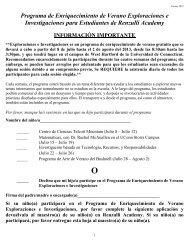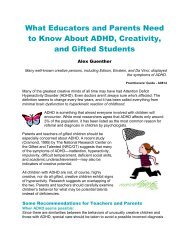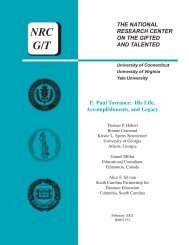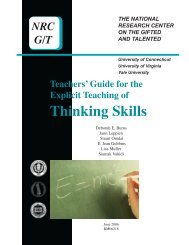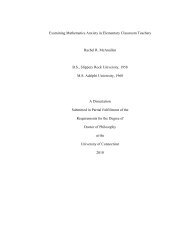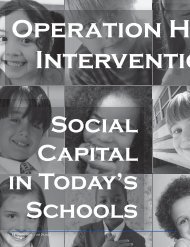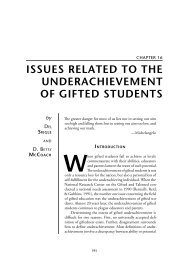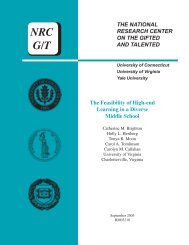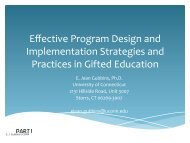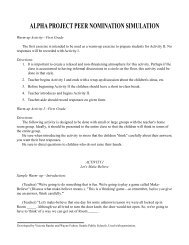Giftedness and High School Dropouts - Neag Center for Gifted ...
Giftedness and High School Dropouts - Neag Center for Gifted ...
Giftedness and High School Dropouts - Neag Center for Gifted ...
You also want an ePaper? Increase the reach of your titles
YUMPU automatically turns print PDFs into web optimized ePapers that Google loves.
10<br />
as a family. In addition to family background, friends also influenced students' decision<br />
to drop out. Cervantes (cited in Sadowski, 1987) found that dropouts did not have many<br />
family friends, <strong>and</strong> their parents did not approve of their friends. <strong>Dropouts</strong> often have<br />
friends <strong>and</strong>/or siblings who have similar problems <strong>and</strong> are also likely to drop out<br />
(Lashaway-Bokina, 1996).<br />
<strong>School</strong>-related Factors in the General Population<br />
The literature has suggested that academic or school-related factors such as<br />
grades, poor reading ability, absence from school, disciplinary problems, academic<br />
failure, lack of interest in school, <strong>and</strong> dislike <strong>for</strong> school <strong>and</strong> teachers are related to<br />
students' decisions to drop out (Beacham, 1980; Beekman, 1987; Curtis et al., 1983;<br />
Durken, 1981; Frazer, 1992; Grossnickle, 1986; Hewitt & Johnson, 1979; Martin, 1982;<br />
Massey & Crosby, 1982; Mayhood, 1981; National <strong>Center</strong> <strong>for</strong> Education Statistics, 1983;<br />
Noth & O' Neil, 1981; Rumberger, 1981; Schreiber, 1979; Self, 1985; Sewell, Palmo, &<br />
Manni, 1981; Strother, 1986; Thornburg, 1975; Young & Reich, 1974).<br />
By interviewing 95 students, Jordan-Davis (cited in Sadowski, 1987) found that<br />
school <strong>and</strong> social factors were related to their decisions to drop out of school. Academic<br />
difficulty in reading <strong>and</strong> writing was the main school-related factor <strong>for</strong> dropping out,<br />
while the two most common social/personal reasons <strong>for</strong> dropping out were pregnancy <strong>and</strong><br />
needing to work full time. Similarly, Mayhood (1981) emphasized that the most<br />
significant factor related to dropping out of school is a lack of reading skills. Due to poor<br />
reading ability, students often failed school <strong>and</strong> repeated failures led to the dropout<br />
decision. Beekman (1987) reported that dropouts listed three major reasons <strong>for</strong> leaving<br />
high school; (a) a dislike of school <strong>and</strong> a view that school is boring <strong>and</strong> not relevant to<br />
their needs; (b) low academic achievement, poor grades, or academic failure; <strong>and</strong> (c) a<br />
need <strong>for</strong> money <strong>and</strong> a desire to work full time. Self's research on secondary school<br />
dropouts (1985) found that several school-related factors were related to the potential<br />
high school dropouts: poor academics, poor reading ability, dislike of school, <strong>and</strong> high<br />
absenteeism. McNeal (1995) also found that participation in extracurricular activities,<br />
such as athletics <strong>and</strong> fine arts, significantly decreases a student's likelihood to drop out.<br />
Beacham (1980) indicated that lack of interest in school is a major reason <strong>for</strong> dropping<br />
out. Similar results were found by Barr <strong>and</strong> Knowles (1986). They found that school<br />
experiences had important influence on students' decisions to drop out. Those students<br />
who left perceived schools as uninteresting <strong>and</strong> boring places that do not provide<br />
challenges (Barr & Knowles, 1986; Lashaway-Bokina, 1996). Using discriminant<br />
function analysis, Frazer (1992) found that four variables were significant in classifying<br />
dropouts: grade point average, being older than other students, being new to the system,<br />
<strong>and</strong> number of days that the student attended eighth grade. Soltys (1990) indicated that<br />
absenteeism, lower grade point averages, <strong>and</strong> higher rates of school suspensions were<br />
significant predictors of students' dropout behavior. On the other h<strong>and</strong>, Cordy (1993)<br />
reported that the presence of a caring adult, a supportive peer group, alternative<br />
educational programs, academic success, motivation to attend post-secondary educational<br />
institutions, <strong>and</strong> participation in fundamental religious groups were positively related<br />
with at-risk students' decisions to stay in school rather than to drop out. Educators who




